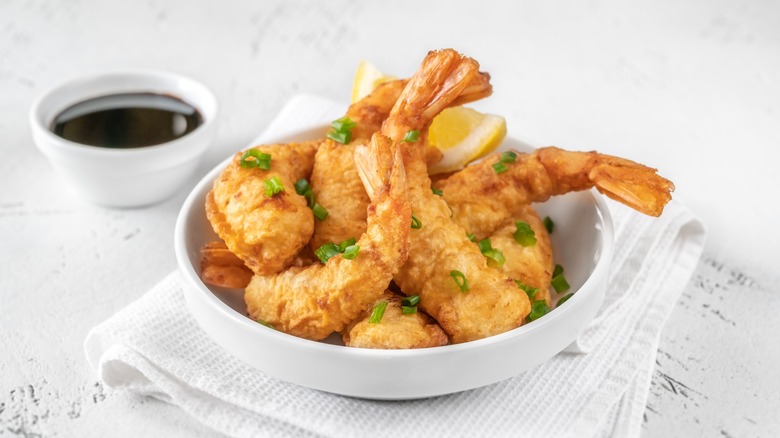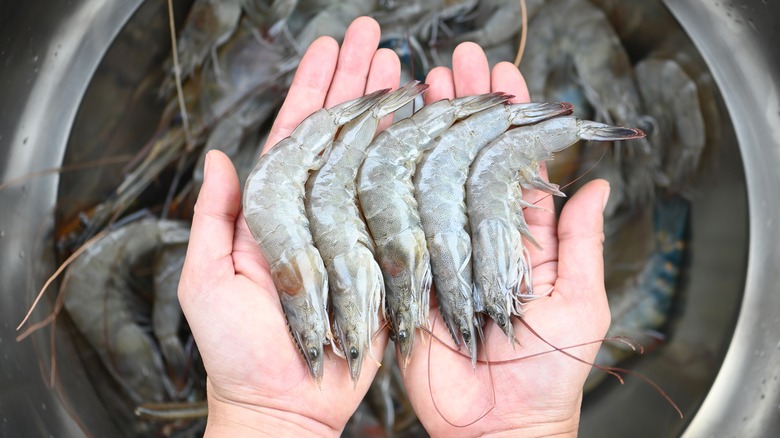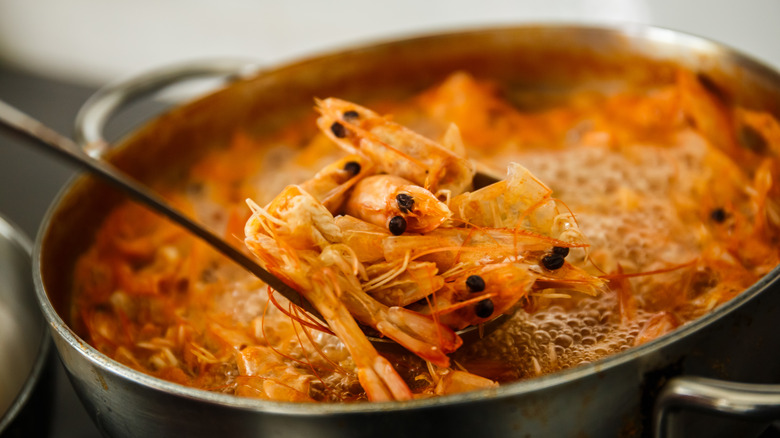Yes, You Can Eat Shrimp Tails. Here's The Best Way To Try It
Whether stirred into a seafood curry or served in a classic shrimp cocktail, shrimp are a delicacy that's hard to refuse. The shell of a shrimp is usually removed before serving to make for easy eating and a neater appearance. However, you may be missing out on some great flavors and crunch if you skip on the tail.
Not only are shrimp tails edible, but they also add a fuller and deeper seafood flavor, as well as a crispy texture, to any dish when prepared the right way. Leave your shrimp tails intact if you're cooking in a sauce or alongside other ingredients to boost the seafood flavors in the whole dish.
Use high-heat cooking methods (such as grilling, sauteing, or roasting) and plenty of fats and spices when cooking shrimp with tails. Heat, fat, and salt ensure the tails cook to a crispy texture and are easy to chew. Avoid water-based or low-heat cooking techniques as these leave your shrimp tails chewy and bland.
For a crispy deep-fried option, try to make shrimp tempura at home. Dip the whole shrimp, tail and all, in batter and fry until golden. The contrasting textures of the crispy tail and tender meat make this a must-try.
Shrimp cook fast (in about two to three minutes when prepared with high heat), so keep a close watch to avoid overcooking. You'll know your shrimp are ready when they take on a tasty "C" shape and the tail has crisped and darkened in color.
Leave your shrimp tails intact for these health benefits
Not only do shrimp tails pack a flavorful punch, but eating them also comes with a long list of benefits from their main components, namely chitin, antioxidants, and minerals. Chitin, the main structural component of shrimp tails, isn't just a texture enhancer. It's also rich in fiber, which supports healthy digestion and gastrointestinal health (per Healthline).
Moreover, shrimp tails come with a bonus of essential trace minerals like calcium, which promotes sturdy bones and healthy teeth (via Harvard School of Public Health). Shrimp tails are also high in magnesium, a mineral that plays an important role in producing energy, transporting calcium and potassium, and synthesizing DNA and antioxidants (per the National Institutes of Health).
Adding to the health perks of shrimp tails is their astaxanthin content. This antioxidant contributes to heart health, supports the immune system, and even shows anti-aging properties, based on a 2017 study by Frontiers in Marine Science. That same study indicates that high values of astaxanthin have also been linked to a decrease in the risk of developing cardiovascular and degenerative diseases.
Repurpose shrimp tails for a tasty stock
If you don't want to actually eat your shrimp tails, but still want to use them for their flavor, why not repurpose them in a seafood stock? Making a homemade seafood stock not only ensures a delicious flavor boost to your recipes but also champions eco-friendliness by repurposing kitchen waste.
Instead of discarding shellfish shells and tails after a meal, freeze them for up to three months until you collect the shells and tails of a pound's worth of shrimp. Once you have enough, use a large skillet and a tablespoon of vegetable oil to brown your shells and tails on low-to-medium heat for about three minutes. Add 1½ cups of water and a pinch of Kosher salt, simmering gently for up to seven minutes.
Remember to stir often and push your shells and tails down to extract as much flavor as possible. Strain the mixture thereafter, and store for up to four days in the refrigerator — but you can always freeze it for up to three months. You can now use your stock to make dishes like Louisiana shrimp étouffée, as well as seafood soups, curries, gumbo, or risotto.



